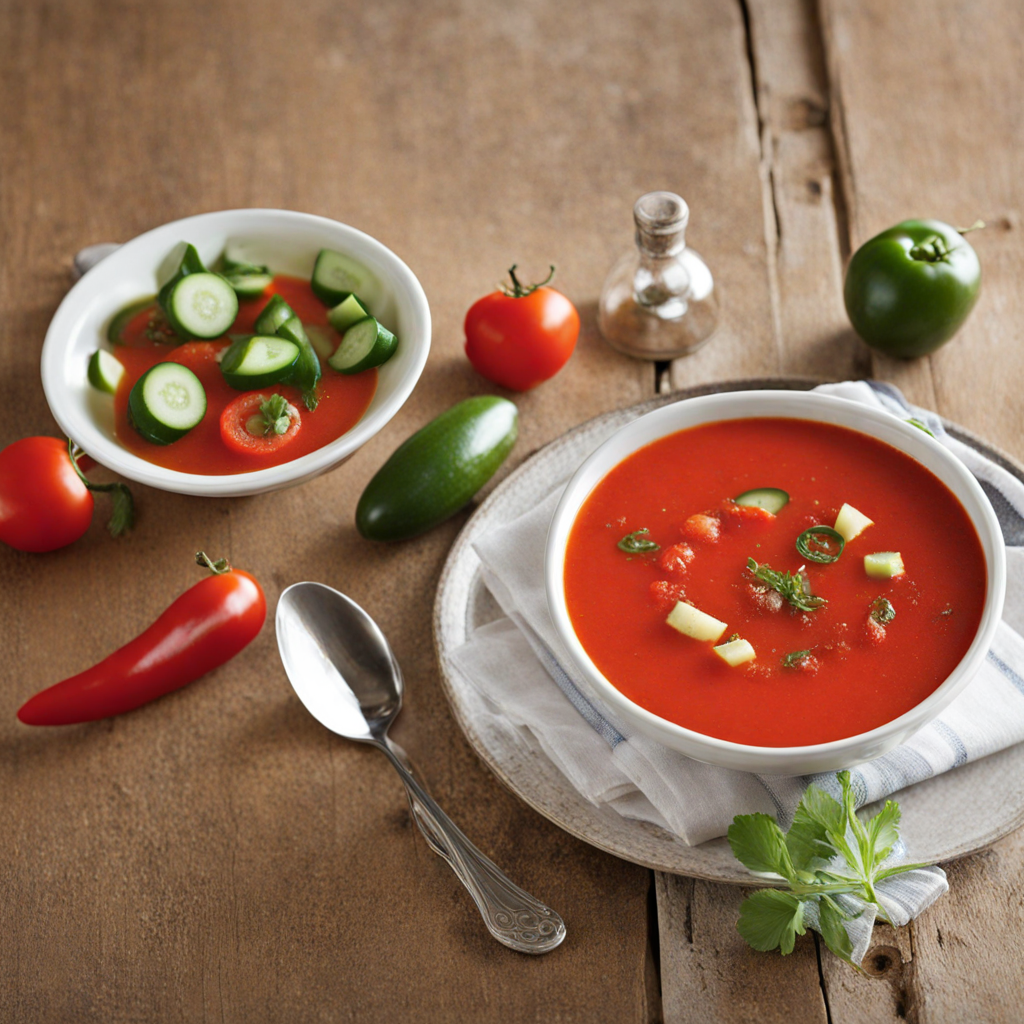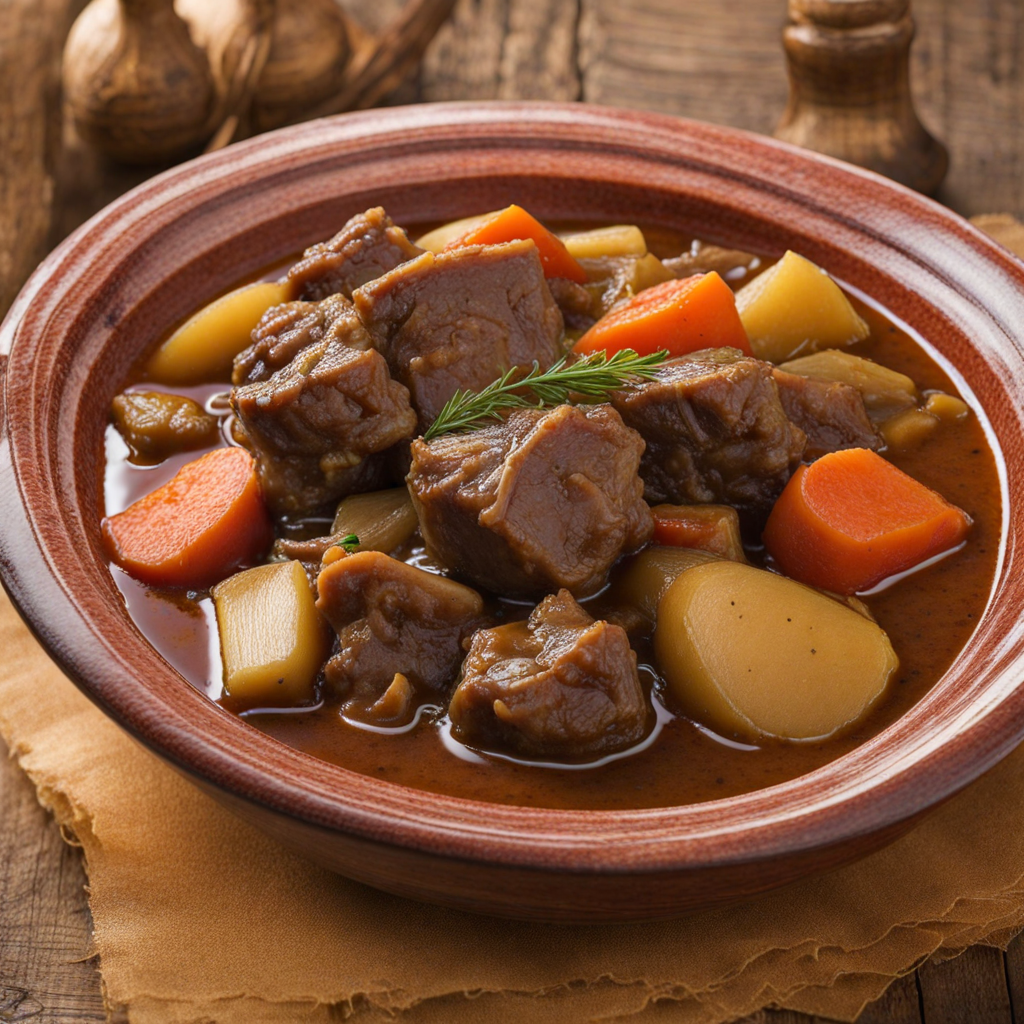Gazpacho
Gazpacho is a refreshing cold soup that hails from the sun-soaked regions of southern Spain, particularly Andalusia. This vibrant dish is made primarily from ripe tomatoes, which form the base, blended together with a medley of fresh vegetables such as cucumbers, bell peppers, onions, and garlic. The ingredients are pureed to create a smooth, velvety texture, resulting in a dish that is not only visually appealing but also bursting with flavor. The use of quality olive oil, vinegar, and sometimes bread adds depth and richness, making every spoonful a delightful experience. The flavor profile of gazpacho is a harmonious balance of acidity and sweetness, with the natural sugars from the tomatoes and peppers complementing the tanginess of the vinegar. Each ingredient contributes to a refreshing and invigorating taste, embodying the essence of summer in Spain. The cool temperature of the soup makes it particularly enjoyable during hot months, offering a light yet satisfying option that can be served as an appetizer or a main course. Some variations may include additional herbs like basil or parsley, enhancing the dish with aromatic notes. Traditionally, gazpacho is garnished with diced vegetables, croutons, or a drizzle of olive oil, adding texture and visual appeal. It is often enjoyed chilled, allowing the flavors to meld beautifully. As you explore this dish, you will discover not just a meal, but a celebration of fresh produce that exemplifies the Mediterranean diet. Gazpacho invites you to savor the simplicity and richness of its ingredients, making it a perfect choice for those looking to indulge in a new and exciting taste of Spanish cuisine.
How It Became This Dish
The Refreshing Legacy of Gazpacho: A Journey Through Time Gazpacho, the chilled soup that epitomizes the culinary essence of southern Spain, particularly Andalusia, is a dish that embodies both the region's agricultural abundance and its rich cultural history. This vibrant dish, with its refreshing flavors and vivid colors, has evolved over centuries, transforming from humble beginnings into a beloved staple of Mediterranean cuisine. Origins The origins of gazpacho can be traced back to ancient times, with roots that intertwine with both Roman and Moorish influences. The word "gazpacho" is believed to derive from the Arabic term "gazpāš," which refers to a type of bread soaked in water. This aligns with the historical practice of using stale bread in the preparation of early forms of gazpacho, serving as a base for the soup. Initially, gazpacho was a rustic dish consumed by farmers and laborers, particularly those working in the hot Andalusian sun. It was a practical solution to the harsh climate, providing hydration and sustenance. The first recorded recipes of gazpacho appeared in the 16th century, with variations incorporating a blend of stale bread, garlic, vinegar, olive oil, and water. The addition of vegetables, particularly tomatoes, peppers, and cucumbers, became common with the introduction of these ingredients to Europe following the Columbian Exchange in the late 15th century. Cultural Significance Gazpacho is more than just a dish; it is a cultural symbol representing the culinary heritage of Andalusia. The importance of gazpacho lies in its ability to reflect the region's agricultural bounty, particularly the abundant produce that flourishes in the Mediterranean climate. In Andalusia, tomatoes, peppers, cucumbers, and garlic are harvested in the summer months, making gazpacho a perfect dish to celebrate the seasonal harvest. Furthermore, gazpacho has become emblematic of the Mediterranean diet, which emphasizes fresh fruits, vegetables, and healthy fats. It serves as a testament to the importance of local ingredients and seasonal cooking, values that have become increasingly relevant in today's food landscape. Gazpacho not only nourishes the body but also embodies a lifestyle that prioritizes health and well-being, echoing the values of Mediterranean cultures. Evolution Over Time The evolution of gazpacho has been marked by regional variations and modern adaptations. While the traditional recipe consists of a simple blend of tomatoes, cucumbers, peppers, garlic, olive oil, vinegar, and stale bread, many chefs and home cooks have experimented with the dish, leading to a diverse array of interpretations. In the 19th and 20th centuries, gazpacho began to gain popularity beyond the borders of Spain, particularly in the United States and other parts of Europe. Its refreshing nature made it an ideal dish for hot summer months, and it became a fashionable appetizer in upscale restaurants. Chefs started to innovate, incorporating different ingredients such as fruits like watermelon or strawberries, creating variations like "salmorejo," a thicker, creamier version of gazpacho that emphasizes the use of bread. The globalization of cuisine in the late 20th century further expanded the reach of gazpacho. As chefs around the world sought to incorporate Spanish flavors into their menus, gazpacho found its way onto a multitude of dining tables, evolving into a dish that could be interpreted through various culinary lenses. Modern Gazpacho In the 21st century, gazpacho has continued to evolve, reflecting contemporary culinary trends such as the emphasis on health, sustainability, and creativity. Chefs now experiment with molecular gastronomy techniques, creating foam or gelée versions of gazpacho, while others focus on organic and locally sourced ingredients, emphasizing the farm-to-table movement. Today, gazpacho can be found in a variety of forms, from traditional recipes served in rustic tavernas to gourmet interpretations served in Michelin-starred restaurants. The dish is not only enjoyed in its native Andalusia but has also become a summer staple in many parts of the world, celebrated for its versatility and refreshing qualities. Conclusion Gazpacho is more than just a cold soup; it is a cultural artifact that tells the story of the land, climate, and people of Andalusia. Its journey from a humble sustenance for laborers to a celebrated dish on international menus reflects the broader narrative of Spanish cuisine and its global influence. As we savor a bowl of gazpacho, we engage with a rich tapestry of history, tradition, and innovation. Each spoonful not only refreshes us in the heat of summer but also connects us to generations of cooks who have embraced the spirit of their land, transforming simple ingredients into a dish that is both nourishing and celebratory. Gazpacho, in all its forms, continues to be a testament to the enduring legacy of Spanish culinary heritage, a dish that unites history, culture, and flavor in every vibrant bite.
You may like
Discover local flavors from Spain







